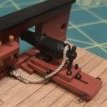-
Posts
3,084 -
Joined
-
Last visited
Reputation Activity
-
 Jaager got a reaction from Canute in Covering up CA
Jaager got a reaction from Canute in Covering up CA
I think that the cold hard solution is to remove the malformed rigging sections and replace with new. This time use either shellac or bookbinders PVA (pH neutral) instead of CA.
A willingness to scrap subpar work and start over is a useful mindset and habit - especially for scratch build. The short redo time will save a much longer time of feeling regret every time you look at the model.
-
 Jaager got a reaction from Justin P. in Covering up CA
Jaager got a reaction from Justin P. in Covering up CA
I think that the cold hard solution is to remove the malformed rigging sections and replace with new. This time use either shellac or bookbinders PVA (pH neutral) instead of CA.
A willingness to scrap subpar work and start over is a useful mindset and habit - especially for scratch build. The short redo time will save a much longer time of feeling regret every time you look at the model.
-
 Jaager reacted to Bob Cleek in wipe-on poly or other final wood treatment education request
Jaager reacted to Bob Cleek in wipe-on poly or other final wood treatment education request
It would seem that the Peanut6's question, which he titled an "education request," invited a comparison of pros and cons of the various options. As something of a "professional" yacht finisher myself once upon a time, I'm glad to hear that glbarlow's cabinet refinishers used something other than shellac or "satin" varnish, neither of which were the best option for the hard use kitchen cabinets endure. "Satin" varnish is best avoided altogether. It lacks UV filters and will degrade quickly in direct sunlight. It's often also difficult to keep the flattening agent evenly in suspension while applying it, resulting in an uneven flat/gloss level on the surface and the flattening paste (dust, essentially) obscures the wood below it. Clear "satin" finishes are made to mimic a real hand-rubbed finish and they do that poorly, at best. Shellac as a final finish on just about anything that will be handled is just wrong, other than on heirloom quality fine furniture, and then only when applied as "French polish," in which each shellac coat is hand-rubbed with oil, resulting in a finish that is a combination of oil and shellac.
A "satin" or "hand-rubbed" look finish is accomplished using a hard top quality clear gloss finish which is hand rubbed with pumice and rottenstone until the desired level of gloss or "satin" is attained. No coatings chemist has yet to produce a brushed or sprayed finish "out of the can" that equals a real hand-rubbed finish. The real hand-rubbed finish is like no other in both appearance and feel. It's clarity and smoothness is unlike anything else. When the nature of a hull lends itself to hand-rubbing, either to depict either a painted or bright (clear) finished surface at "scale viewing distance," a real hand-rubbed finish is unequaled for that application.
If it makes the polyurethane fans feel any better, Hamburg-made Steinway pianos have been finished with a sprayed polyester finish for the last 30 years or so and have a deep high-gloss finish. New York Steinway pianos, an entirely different model with different tonal qualities, are finished with hand-rubbed lacquer and have a deep satin finish. Nobody knows fine finishes better than the Steinway company and even they find it useful to use two different coatings for different reasons to finish their pianos. You can be sure, though, that Steinway isn't using shellac or "wipe on poly" on any of its pianos!
For those wood finishing wonks, here's an interesting article on how Steinways are refinished: The Art of Refinishing a Piano | Steinway and Sons Piano Refinishing (chuppspianos.com)
-
 Jaager got a reaction from thibaultron in Covering up CA
Jaager got a reaction from thibaultron in Covering up CA
I think that the cold hard solution is to remove the malformed rigging sections and replace with new. This time use either shellac or bookbinders PVA (pH neutral) instead of CA.
A willingness to scrap subpar work and start over is a useful mindset and habit - especially for scratch build. The short redo time will save a much longer time of feeling regret every time you look at the model.
-
 Jaager got a reaction from EricWilliamMarshall in "material" of the ships fitting, or what color do I paint it?
Jaager got a reaction from EricWilliamMarshall in "material" of the ships fitting, or what color do I paint it?
Kearnold,
If this is not 'one-off' model and you intend to build others, you might consider using this as an opportunity to dip your toe into the scratch build world. Replace the wooden component castings with dublicates that you fabricate using actual scale appropriate wood. You should research the actual scantlings of the parts to be built. The castings may be over scale to begin with.
If you can make friends with a near by modeler who has the proper tools, The choice of wood species available to you is much greater than that available to those who fabricate hulls. The parts that you need can come from the same stock as those turning pens since it is all small. The choices available as 4x4 and 8x4 lumber are much fewer in number.
-
 Jaager got a reaction from wefalck in Covering up CA
Jaager got a reaction from wefalck in Covering up CA
I think that the cold hard solution is to remove the malformed rigging sections and replace with new. This time use either shellac or bookbinders PVA (pH neutral) instead of CA.
A willingness to scrap subpar work and start over is a useful mindset and habit - especially for scratch build. The short redo time will save a much longer time of feeling regret every time you look at the model.
-
 Jaager got a reaction from mtaylor in Covering up CA
Jaager got a reaction from mtaylor in Covering up CA
I think that the cold hard solution is to remove the malformed rigging sections and replace with new. This time use either shellac or bookbinders PVA (pH neutral) instead of CA.
A willingness to scrap subpar work and start over is a useful mindset and habit - especially for scratch build. The short redo time will save a much longer time of feeling regret every time you look at the model.
-
 Jaager got a reaction from BenD in Beginner marking tools
Jaager got a reaction from BenD in Beginner marking tools
Boy! Is this something that is prone to get into a love me, love my tools sort of zone.
I will just show my most often go-to basic tools for this
First is a 6 inch steel ruler - Imperial and metric. The ships I model are Imperial based, but metric is easier to subdivide a distance with.
a 3 inch machinist's square
a technical lead pen with soft lead 2mm insert and a piece of 220 grit sandpaper to keep a ~60 degree wedge instead of a circular point.
Old time woodworkers seem to prefer a knife mark and a violin makers knife like this 3mm
I did not learn about a knife mark until I was too set in my ways.
-
 Jaager reacted to mtaylor in Beginner marking tools
Jaager reacted to mtaylor in Beginner marking tools
If you'll go to the article database here (https://thenrg.org/resource/articles) there's two relevant topics... The first is "Plans and Research" and the second is "Materials and Tools". Unless you're like many of us, myself included) and are a toolholic, only buy tools as you need them and as you progress on your modeling.
-
 Jaager got a reaction from Bob Cleek in wipe-on poly or other final wood treatment education request
Jaager got a reaction from Bob Cleek in wipe-on poly or other final wood treatment education request
Poly urethane is a plastic. I used it on my Walnut stained Oak kitchen floor in KY. It looked good and held up well. It certainly has its fans here for use on a model. If you like a plastic look on a model on a vessel from 100+ years ago, it is worth a look. It is simple enough to use.
Should you be more traditionally oriented, a simple, low cost, forgiving material is shellac. More coats more depth. Too shiny, Scotch Brite, steel wool, or bronze wool will dull it.
A low cost way is
Lee Valley shellac flakes 1/4 lb - choice of 3 shades for how warm and aged you are going for.
a can of denatured alcohol
for light 10% is enough (10 g in 100 ml) the medium can probably be 20% , and the dark maybe 30%.
Rag or brush to apply.
If you double or triple bag the dry flakes and put them in a freezer they should store for years. just make sure that they are RT before you open the stored flakes.
It comes pre-mixed (avoid the silly aerosol version) just be aware that the shelf life is limited.
A rule that learned in organic chem is that a reaction rate doubles for every 10 degree C temp rise. Going from 20 C to -10 /20 C is a 4-8-16 times longer half life for a compound prone to oxidation.
-
 Jaager got a reaction from thibaultron in wipe-on poly or other final wood treatment education request
Jaager got a reaction from thibaultron in wipe-on poly or other final wood treatment education request
Poly urethane is a plastic. I used it on my Walnut stained Oak kitchen floor in KY. It looked good and held up well. It certainly has its fans here for use on a model. If you like a plastic look on a model on a vessel from 100+ years ago, it is worth a look. It is simple enough to use.
Should you be more traditionally oriented, a simple, low cost, forgiving material is shellac. More coats more depth. Too shiny, Scotch Brite, steel wool, or bronze wool will dull it.
A low cost way is
Lee Valley shellac flakes 1/4 lb - choice of 3 shades for how warm and aged you are going for.
a can of denatured alcohol
for light 10% is enough (10 g in 100 ml) the medium can probably be 20% , and the dark maybe 30%.
Rag or brush to apply.
If you double or triple bag the dry flakes and put them in a freezer they should store for years. just make sure that they are RT before you open the stored flakes.
It comes pre-mixed (avoid the silly aerosol version) just be aware that the shelf life is limited.
A rule that learned in organic chem is that a reaction rate doubles for every 10 degree C temp rise. Going from 20 C to -10 /20 C is a 4-8-16 times longer half life for a compound prone to oxidation.
-
 Jaager got a reaction from thibaultron in "material" of the ships fitting, or what color do I paint it?
Jaager got a reaction from thibaultron in "material" of the ships fitting, or what color do I paint it?
Kearnold,
If this is not 'one-off' model and you intend to build others, you might consider using this as an opportunity to dip your toe into the scratch build world. Replace the wooden component castings with dublicates that you fabricate using actual scale appropriate wood. You should research the actual scantlings of the parts to be built. The castings may be over scale to begin with.
If you can make friends with a near by modeler who has the proper tools, The choice of wood species available to you is much greater than that available to those who fabricate hulls. The parts that you need can come from the same stock as those turning pens since it is all small. The choices available as 4x4 and 8x4 lumber are much fewer in number.
-
 Jaager got a reaction from thibaultron in Degradation of lead and Britannia fittings
Jaager got a reaction from thibaultron in Degradation of lead and Britannia fittings
John,
I would think that a clear coat of the organic solvent sort would buy you time, but if the "white glue" is PVA, that has the potential to be a disaster. The final product in lead disease is lead acetate -I believe.
I am not sure how much if any acetate is in bookbinders PVA, but all other woodworkers PVA has as much acetic acid as 5% vinegar. My guess is that a PVA coat would accelerate the disintegration of a lead casting.
The clear coat using lacquer et al. has the disadvantage of not being glass and thus allowing gases to migrate across it. A quick smell of vinegar tells you that acetic acid is partially a gas at RT.
-
 Jaager got a reaction from kearnold in "material" of the ships fitting, or what color do I paint it?
Jaager got a reaction from kearnold in "material" of the ships fitting, or what color do I paint it?
Kearnold,
If this is not 'one-off' model and you intend to build others, you might consider using this as an opportunity to dip your toe into the scratch build world. Replace the wooden component castings with dublicates that you fabricate using actual scale appropriate wood. You should research the actual scantlings of the parts to be built. The castings may be over scale to begin with.
If you can make friends with a near by modeler who has the proper tools, The choice of wood species available to you is much greater than that available to those who fabricate hulls. The parts that you need can come from the same stock as those turning pens since it is all small. The choices available as 4x4 and 8x4 lumber are much fewer in number.
-
 Jaager got a reaction from flyer in Paint and varnish thoughts, recommendations
Jaager got a reaction from flyer in Paint and varnish thoughts, recommendations
This is something that I did not want to hear when it was first published in the NRJ, but scale has a definite effect on just how much gloss a paint finish should have.
Even at 1:24 egg shell or matte would better approximate a full size gloss hull seen from 24 feet away - is what I am thinking.
High gloss on a model runs the danger of making it look like a toy.
-
 Jaager got a reaction from Canute in Beginner marking tools
Jaager got a reaction from Canute in Beginner marking tools
Boy! Is this something that is prone to get into a love me, love my tools sort of zone.
I will just show my most often go-to basic tools for this
First is a 6 inch steel ruler - Imperial and metric. The ships I model are Imperial based, but metric is easier to subdivide a distance with.
a 3 inch machinist's square
a technical lead pen with soft lead 2mm insert and a piece of 220 grit sandpaper to keep a ~60 degree wedge instead of a circular point.
Old time woodworkers seem to prefer a knife mark and a violin makers knife like this 3mm
I did not learn about a knife mark until I was too set in my ways.
-
 Jaager got a reaction from Canute in Sandpaper
Jaager got a reaction from Canute in Sandpaper
Following a suggestion from Don Vardas :
"For the time being, use a heavy grit paper (80 is about the best) for your initial "rough" sand and finish it off with lighter grits to 240 grit. If you Contact Cement the paper to a cork block it makes it a lot easier too. Buy an extra cork block and shape a "half-round" into it to do inside curves."
I bought a cork bock sold for Yoga. Using my bandsaw I cut a variety of small blocks curved and angled. But rather than the aggressive and messy contact cement, I use rubber cement. It hold well enough as long as both surfaces are coated and allowed to dry before mounting the paper. This does preclude the use of Norton 7X or 10X most commonly found in big box hardware shops. Rubber cement does not like the no skid coating on the back.
-
 Jaager got a reaction from Canute in Sandpaper
Jaager got a reaction from Canute in Sandpaper
For surfaces that meet and are PVA bonded, 220 grit is right at the edge of not leaving a surface rough enough for the polymer chains to grip. I am sort of OCD about 220 grit and that fine is pushing it, I think, but my structures hold.
From what I read, open coat aluminum oxide is the gold standard for wood.
-
 Jaager got a reaction from Keith Black in Beginner marking tools
Jaager got a reaction from Keith Black in Beginner marking tools
Boy! Is this something that is prone to get into a love me, love my tools sort of zone.
I will just show my most often go-to basic tools for this
First is a 6 inch steel ruler - Imperial and metric. The ships I model are Imperial based, but metric is easier to subdivide a distance with.
a 3 inch machinist's square
a technical lead pen with soft lead 2mm insert and a piece of 220 grit sandpaper to keep a ~60 degree wedge instead of a circular point.
Old time woodworkers seem to prefer a knife mark and a violin makers knife like this 3mm
I did not learn about a knife mark until I was too set in my ways.
-
 Jaager got a reaction from barkeater in Beginner marking tools
Jaager got a reaction from barkeater in Beginner marking tools
Boy! Is this something that is prone to get into a love me, love my tools sort of zone.
I will just show my most often go-to basic tools for this
First is a 6 inch steel ruler - Imperial and metric. The ships I model are Imperial based, but metric is easier to subdivide a distance with.
a 3 inch machinist's square
a technical lead pen with soft lead 2mm insert and a piece of 220 grit sandpaper to keep a ~60 degree wedge instead of a circular point.
Old time woodworkers seem to prefer a knife mark and a violin makers knife like this 3mm
I did not learn about a knife mark until I was too set in my ways.
-
 Jaager got a reaction from mtaylor in Beginner marking tools
Jaager got a reaction from mtaylor in Beginner marking tools
Boy! Is this something that is prone to get into a love me, love my tools sort of zone.
I will just show my most often go-to basic tools for this
First is a 6 inch steel ruler - Imperial and metric. The ships I model are Imperial based, but metric is easier to subdivide a distance with.
a 3 inch machinist's square
a technical lead pen with soft lead 2mm insert and a piece of 220 grit sandpaper to keep a ~60 degree wedge instead of a circular point.
Old time woodworkers seem to prefer a knife mark and a violin makers knife like this 3mm
I did not learn about a knife mark until I was too set in my ways.
-

-
 Jaager got a reaction from Justin P. in Sandpaper
Jaager got a reaction from Justin P. in Sandpaper
Following a suggestion from Don Vardas :
"For the time being, use a heavy grit paper (80 is about the best) for your initial "rough" sand and finish it off with lighter grits to 240 grit. If you Contact Cement the paper to a cork block it makes it a lot easier too. Buy an extra cork block and shape a "half-round" into it to do inside curves."
I bought a cork bock sold for Yoga. Using my bandsaw I cut a variety of small blocks curved and angled. But rather than the aggressive and messy contact cement, I use rubber cement. It hold well enough as long as both surfaces are coated and allowed to dry before mounting the paper. This does preclude the use of Norton 7X or 10X most commonly found in big box hardware shops. Rubber cement does not like the no skid coating on the back.
-
 Jaager got a reaction from mtaylor in Sandpaper
Jaager got a reaction from mtaylor in Sandpaper
Following a suggestion from Don Vardas :
"For the time being, use a heavy grit paper (80 is about the best) for your initial "rough" sand and finish it off with lighter grits to 240 grit. If you Contact Cement the paper to a cork block it makes it a lot easier too. Buy an extra cork block and shape a "half-round" into it to do inside curves."
I bought a cork bock sold for Yoga. Using my bandsaw I cut a variety of small blocks curved and angled. But rather than the aggressive and messy contact cement, I use rubber cement. It hold well enough as long as both surfaces are coated and allowed to dry before mounting the paper. This does preclude the use of Norton 7X or 10X most commonly found in big box hardware shops. Rubber cement does not like the no skid coating on the back.
-
 Jaager reacted to Bob Cleek in Sandpaper
Jaager reacted to Bob Cleek in Sandpaper
"There's an app for that." Stock item at auto body and fender supply houses. Expensive, but a little goes a long way and you'll make up the difference in sandpaper savings.
Additionally, particularly with power driven abrasive disks and belts, the regular use of a crepe rubber cleaning stick will extend the life of the abrasive sheet considerably. They are cheap and last forever. POWERTEC 71002 Abrasive Cleaning Stick for Sanding Belts & Discs | Natural Rubber Eraser - Woodworking Shop Tools for Sanding Perfection - Vacuum And Dust Collector Accessories - Amazon.com






.thumb.jpeg.fc5d633a7b34428fcf19419a73d56d55.jpeg)





